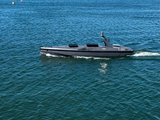US Navy's MUOS-4 moves toward 2015 launch date
The US Navy’s newest Mobile User Objective System (MUOS) satellite is progressing toward its 2015 launch date, with Lockheed Martin completing thermal vacuum testing on the satellite.
MUOS-4 underwent thermal vacuum testing inside the Dual Entry Large Thermal Altitude chamber at Lockheed Martin’s Sunnyvale, California satellite integration facility during November. The system will now proceed to final integrated testing ahead of its launch - expected in the second half of 2015 – when it will complete the operational MUOS constellation and provide global coverage.
MUOS operates like a smart-phone cell tower in the sky, providing significantly improved secure mobile satellite communications for warfighters on the move. For the first time, MUOS Wideband Code Division Multiple Access technology users will have beyond-line-of-sight capability to transmit and receive voice and data using an Internet Protocol-based system.
Iris Bombelyn, vice president, narrowband communications mission area, Lockheed Martin, said: ‘The successful completion of thermal vacuum testing assures that MUOS-4 can endure the extreme hot and cold temperatures it will experience throughout its on-orbit mission life. The delivery of this fixed price vehicle shows a clear advantage for block buys to drive down defects and maintain low costs through learning curve advantages.’
MUOS-3 was shipped to Cape Canaveral Air Force Station in early November in anticipation of its January launch.
Lockheed Martin is currently under contract for five MUOS spacecraft. MUOS-2 was launched and handed over to the US Navy for operations in 2013; while MUOS-1 launched and became operational in 2012. MUOS-5 is expected to launch in 2016.
Lockheed Martin Space Systems, Sunnyvale, California, is the MUOS prime contractor and system integrator. The US Navy's Program Executive Office for Space Systems and its Communications Satellite Program Office, San Diego, California, are responsible for the MUOS programme.
More from Digital Battlespace
-
![Babcock nears first customer for Nomad AI translation tool]()
Babcock nears first customer for Nomad AI translation tool
Nomad can provide militaries with real-time intelligence, saving critical time on the battlefield.
-
![AUSA 2025: Israel’s Asio Technologies to supply hundreds of improved Taurus tactical systems]()
AUSA 2025: Israel’s Asio Technologies to supply hundreds of improved Taurus tactical systems
Taurus operates alongside the Israel Defense Forces’ Orion system which supports mission management across tens of thousands of manoeuvring forces, from squad leaders to battalion commanders.
-
![AUSA 2025: Kopin pushes micro-LED plans as China moves faster]()
AUSA 2025: Kopin pushes micro-LED plans as China moves faster
The plan for the new displays follows fresh investment in Kopin’s European facilities by Theon and an order for head-up displays in fielded aircraft, with funding from the US Department of Defense.
-
![AUSA 2025: Persistent Systems to complete its largest order by year’s end]()
AUSA 2025: Persistent Systems to complete its largest order by year’s end
Persistent Systems received its largest ever single order for its MPU5 devices and other systems earlier this month and has already delivered the 50 units to the US Army’s 4th Infantry Division.
-
![Aselsan brings in dozens of companies and systems under the Steel Dome umbrella]()
Aselsan brings in dozens of companies and systems under the Steel Dome umbrella
Turkey has joined the family of countries attempting to establish a multilayered air defence system with government approval in August 2024 for the effort landed by Aselsan. Dubbed Steel Dome, the programme joins Israel’s Iron Dome, the US Golden Dome, India’s Mission Sudarshan Chakra and South Korea’s low-altitude missile defence system.
-
![DSEI 2025: MARSS unveils new agnostic multidomain C4 system]()
DSEI 2025: MARSS unveils new agnostic multidomain C4 system
MARSS’ NiDAR system has been deployed using sensors from static platforms to provide detection and protection for static sights, such as critical infrastructure, ports and military bases.

























